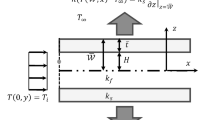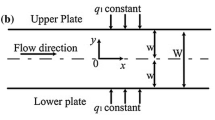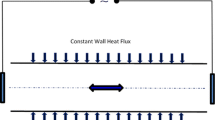Abstract
The heat transfer characteristics of the thermally developing flow in the circular and parallel plates microchannels under the constant wall temperature and the constant heat flux are studied analytically. The energy equations are solved by using the separation of variables combined with the Gram–Schmidt orthogonalization. The effect of the number of eigenvalues on the calculation accuracy of the local Nusselt number is first determined. The temperature distribution and the heat transfer coefficient at the entrance region are calculated considering the effects of the rarefaction (0 < Kn < 0.1) and the axial heat conduction (Pe > 50). It is found that the axial heat conduction can dramatically improve the heat transfer of the thermally developing flow when the Peclet number is less than 250. But when the Peclet number is greater than 500, the effect of the axial heat conduction can be omitted. Enhancing the rarefaction would weaken the influence of the axial heat conduction on the heat transfer, and the difference of the local Nusselt number between the two boundary conditions decreases as increasing Kn. Enhancing fluid axial heat conduction would increase the thermal entrance length. The thermal entrance length of the microtube is 3–4 times that of the parallel plates microchannel, and the correlations of the thermal entrance lengths are developed, which may provide guidance for thermal design and optimization of microchannel heat sinks.














Similar content being viewed by others
Abbreviations
- c p :
-
Specific heat (J kg−1 K−1)
- C n :
-
Coefficient in Eq. (16)
- D h :
-
Hydraulic diameter (m)
- h :
-
Convective heat transfer coefficient (W m−2 K−1)
- k :
-
Parameter defined by Eq. (39)
- Kn :
-
Knudsen number
- Kn u :
-
Modified Knudsen number = Kn(2–σv)/σv
- Nu :
-
Nusselt number
- p :
-
Geometry parameter
- Pe :
-
Peclet number
- Pr :
-
Prandtl number
- Q :
-
Internal heat generation (W m−3)
- q :
-
Heat flux (W m−2)
- r :
-
R-Coordinate (m)
- T :
-
Temperature (K)
- u :
-
Fluid velocity (m s−1)
- x :
-
X-Coordinate (m)
- x*:
-
Non-dimensional length = x/(DhPe)
- y :
-
Y-Coordinate (m)
- β :
-
Coefficient of thermal expansion (K−1)
- γ :
-
Ratio of specific heats
- θ :
-
Dimensionless temperature
- κ :
-
Fluid thermal conductivity (W m−1 K−1)
- λ :
-
Mean free path (m)
- \({\uplambda }_{{\text{n}}}^{{2}}\) :
-
Eigenvalue
- μ :
-
Dynamic viscosity (N s m−2)
- ρ :
-
Fluid density (kg m−3)
- σ v :
-
Tangential momentum accommodation coefficient
- σ T :
-
Thermal accommodation coefficient
- Φ:
-
Viscous dissipation function
- \(\phi_{n}\) :
-
Eigenfunction
- ∞ :
-
Fully developed region
- c:
-
Microtube
- m:
-
Mean
- p:
-
Parallel plates microchannel
- w:
-
Wall
- in:
-
Inlet
- CM:
-
Circular microchannel
- PPM:
-
Parallel plates microchannel
References
Agrawal A, Kushwaha H M and Jadhav R S 2020 Microscale flow and heat transfer. Springer International Publishing, Cham
Bennett T D 2019 Correlations for the Graetz problem in convection – Part 1: for round pipes and parallel plates. Int. J. Heat Mass Transf. 136: 832–841
Shah R K and London A L 1978 Laminar flow forced convection in ducts, Suppl. l, Advanced Heat Transfer. New York: Academic Press
Barron R F, Wang X, Ameel T and Warrington R O 1997 The Graetz problem extended to slip-flow. Int. J. Heat Mass Transf. 40(8): 1817–1823
Barron R F, Wang X, Warrington R O and Ameel T A 1996 Evaluation of the eigenvalues for the graetz problem in slip-flow. Int. Commun. Heat Mass Transf. 23(4): 563–574
Ameel T A, Wang X, Barron R F and Warrington R O 1997 Laminar forced convection in a circular tube with constant heat flux and slip flow. Microsc. Thermophys. Eng. 1(4): 303–320
Larrode F E, Housiadas C and Drossinos Y 2000 Slip-flow heat transfer in circular tubes. Int. J. Heat Mass Transf. 43: 2669–2680
Tunc G and Bayazitoglu Y 2001 Heat transfer in microtubes with viscous dissipation. Int. J. Heat Mass Transf. 44(13): 2395–2403
Xu F and Ma H 2012 Analytical solution of the Graetz problem extended to slip-flow in microtube. J. Heat Transf. 134(10): 2–3
Duan Z and He B 2014 Extended Reynolds analogy for slip and transition flow heat transfer in microchannels and nanochannels. Int. Commun. Heat Mass Transf. 56: 25–30
Hooman K, Li J and Dahari M 2016 Slip flow forced convection through microducts of arbitrary cross-section: Heat and momentum analogy. Int. Commun. Heat Mass Transf. 71: 176–179
Chalhub D J N M, Sphaier L A and Alves L S D B 2016 Integral transform solution for thermally developing slip-flow within isothermal parallel plates. Comput. Therm. Sci. 8(2): 147–161
Haddout Y, Essaghir E, Oubarra A and Lahjomri J 2018 Convective heat transfer for a gaseous slip flow in micropipe and parallel-plate microchannel with uniform wall heat flux: effect of axial heat conduction. Indian J. Phys. 92(6): 741–755
Lahjomri J, Oubarra A and Alemany A 2002 Heat transfer by laminar Hartmann flow in thermal entrance eregion with a step change in wall temperatures: the Graetz problem extended. Int. J. Heat Mass Transf. 45(5): 1127–1148
Kalyoncu G and Barisik M 2016 The extended Graetz problem for micro-slit geometries; analytical coupling of rarefaction, axial conduction and viscous dissipation. Int. J. Therm. Sci. 110: 261–269
Saha S K, Agrawal A and Soni Y 2017 Heat transfer characterization of rhombic microchannel for H1 and H2 boundary conditions. Int. J. Therm. Sci. 111: 223–233
Kuddusi L and Cetegen E 2009 Thermal and hydrodynamic analysis of gaseous flow in trapezoidal silicon microchannels. Int. J. Therm. Sci. 48(2): 353–362
Tso C P, Sheela-Francisca J and Hung Y M 2010 Viscous dissipation effects of power-law fluid flow within parallel plates with constant heat fluxes. J. Non-Newtonian Fluid Mech. 165(11–12): 625–630
Chen S 2010 Lattice Boltzmann method for slip flow heat transfer in circular microtubes: Extended Graetz problem. Appl. Math. Comput. 217(7): 3314–3320
Hong C, Asako Y and Suzuki K 2011 Heat transfer characteristics of gaseous slip flow in concentric micro-annular tubes. J. Heat Transf. 133
Kabar Y, Bessaïh R and Rebay M 2013 Conjugate heat transfer with rarefaction in parallel plates microchannel. Superlattice Microst. 60: 370–388
Loussif N and Orfi J 2014 Simultaneously developing laminar flow in an isothermal micro-tube with slip flow models. Heat Mass Transf. 50: 573–582
Haase A S, Chapman S J, Tsai P A, Lohse D and Lammertink R G 2015 The Graetz–Nusselt problem extended to continuum flows with finite slip. J. Fluid Mech. 764
Kumar R and Mahulikar S P 2021 Effect of density variation on rarefied and non-rarefied gaseous flows in developing region of microtubes. Iranian J. Sci. Technol. Trans. Mech. Eng. 45(2): 415–425
Şen S 2019 Numerical investigation of the effect of second order slip flow conditions on interfacial heat transfer in micro pipes. Sadhana – Acad. Proceed. Eng. Sci. 44(7)
Saghafian M, Saberian I, Rajabi R and Shirani E 2015 A numerical study on slip flow heat transfer in micro-poiseuille flow using perturbation method. J. Appl. Fluid Mech. 8(1): 123–132
Yu F, Wang T and Zhang C 2018 Effect of axial conduction on heat transfer in a rectangular microchannel with local heat flux. J. Therm. Sci. Technol. 13(1): 1–13
Hemadri V, Biradar G S, Shah N, Garg R, Bhandarkar U V and Agrawal A 2018 Experimental study of heat transfer in rarefied gas flow in a circular tube with constant wall temperature. Exp. Therm. Fluid Sci. 93: 326–333
Tada S and Ichimiya K 2007 Numerical simulation of forced convection in a porous circular tube with constant wall heat flux: An extended Graetz problem with viscous dissipation. Chem. Eng. Technol. 30(10): 1362–1368
Renksizbulut M and Niazmand H 2016 Laminar flow and heat transfer in the entrance region. J. Heat Transf. 128: 63–74
Avci M and Aydin O 2018 Analysis of extended micro-Graetz problem in a microtube. Sadhana – Acad. Proceed. Eng. Sci. 43(7): 1–9
Barişik M, Yazicioğlu A G, Çetin B and Kakaç S 2015 Analytical solution of thermally developing microtube heat transfer including axial conduction, viscous dissipation, and rarefaction effects. Int. Commun. Heat Mass Transf. 67: 81–88
Telles A S, Queiroz E M and Elmôr Filho G 2001 Solutions of the extended Graetz problem. Int. J. Heat Mass Transf. 44(2): 471–483
Jambal O, Shigechi T, Davaa G and Momoki S 2005 Effects of viscous dissipation and fluid axial heat conduction on heat transfer for non-Newtonian fluids in ducts with uniform wall temperature: Part I: Parallel plates and circular ducts. Int. Commun. Heat Mass Transf. 32(9): 1165–1173
Renksizbulut M, Niazmand H and Tercan G 2006 Slip-flow and heat transfer in rectangular microchannels with constant wall temperature. Int. J. Therm. Sci. 45(9): 870–881
Jeong H E and Jeong J T 2006 Extended Graetz problem including axial conduction and viscous dissipation in microtube. J. Mech. Sci. Technol. 20(1): 158–166
Myong R S, Lockerby D A and Reese J M 2006 The effect of gaseous slip on microscale heat transfer: An extended Graetz problem. Int. J. Heat Mass Transf. 49(15–16): 2502–2513
Hettiarachchi H D M, Golubovic M, Worek W M and Minkowycz W J 2008 Three- dimensional laminar slip-flow and heat transfer in a rectangular microchannel with constant wall temperature. Int. J. Heat Mass Transf. 51(21–22): 5088–5096
van Rij J, Ameel T and Harman T 2009 The effect of viscous dissipation and rarefaction on rectangular microchannel convective heat transfer. Int. J. Therm. Sci. 48: 271–281
Saghafian M, Saberian I, Rajabi R and Shirani E 2015 A numerical study on slip flow heat transfer in micro-poiseuille flow using perturbation method. J. Appl. Fluid Mech. 8: 123–132
Loussif N and Orfi J 2015 Slip flow heat transfer in micro-tubes with viscous dissipation. Desalin. Water Treat. 53: 1263–1274
Ramadan K M, Kamil M and Bataineh M S 2019 Conjugate heat transfer in a microchannel simultaneously developing gas flow: a vorticity stream function-based numerical analysis. J. Therm. Sci. Eng. Appl. 11
Sun Q, Choi K S and Mao X 2020 An analytical solution of convective heat transfer in microchannel or nanochannel. Int. Commun. Heat Mass Transf. 117: 104766
Bejan A 2013 Convection Heat Transfer. John Wiley and Sons, New York
Duan Z and He B 2018 Further study on second-order slip flow models in channels of various cross sections. Heat Transf. Eng. 39(11): 933–945
Abramowitz M and Stegun I A 1972 Handbook of Mathematical Functions. Dover Publications, New York
Cetin B and Bayer O 2011 Evaluation of Nusselt number for a flow in a microtube using second-order slip model. Therm. Sci. 15(suppl. 1): 103–109
Su L, Duan Z, He B, Ma H, Ning X, Ding G and Cao Y 2020 Heat transfer characteristics of thermally developing flow in rectangular microchannels with constant wall temperature. Int. J. Therm. Sci. 155: 106412
Colin S 2012 Gas microflows in the slip flow regime: A critical review on convective heat transfer. J. Heat Transf. 134(2)
Acknowledgements
This research was supported by the Talents Special Fund of China Three Gorges University (No. 8210403).
Author information
Authors and Affiliations
Corresponding author
Appendix A: Steps of Gram-Schmidt orthogonalization to obtain C n
Appendix A: Steps of Gram-Schmidt orthogonalization to obtain C n
For the eigenfunctions sequence {ϕn}, assuming that the orthogonalized function sequences are {gn}, the relationship between the above two is as follows
For the orthogonal function sequences {gn}, there is the following orthogonal property when i ≠ j
Substituting (A-1) and (A-2) into (A-5) yields
then
More generally,
Based on the inlet boundary condition, setting the coefficient of the eigenfunctions after the orthogonalization is Bn, namely
and
The coefficient Bn can be obtained based on the characteristics of the orthogonal function:
According to (A-1)–(A-4), we have
After determining Bn, Cn can be calculated according to (A-9), that is
where
Rights and permissions
About this article
Cite this article
Su, L., He, B. & Yu, W. Analytical solution of thermally developing heat transfer in circular and parallel plates microchannels. Sādhanā 47, 219 (2022). https://doi.org/10.1007/s12046-022-01951-x
Received:
Revised:
Accepted:
Published:
DOI: https://doi.org/10.1007/s12046-022-01951-x




